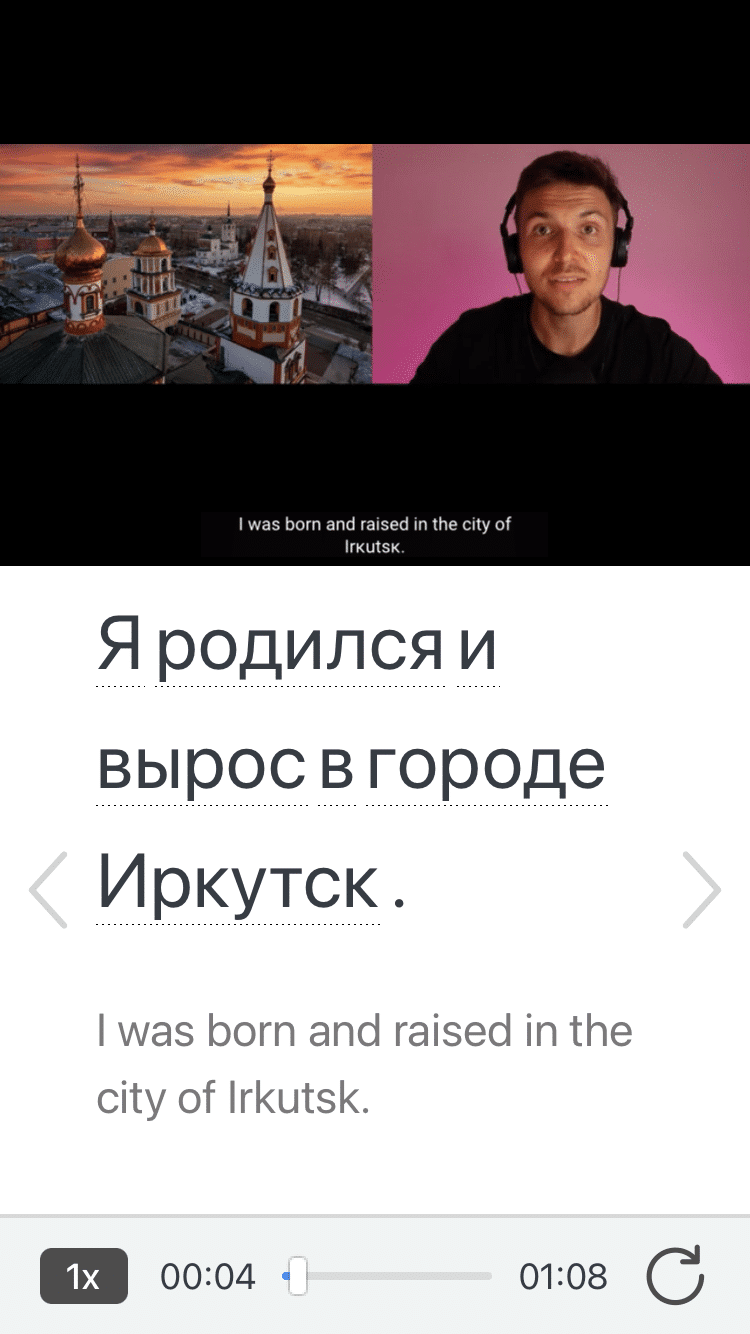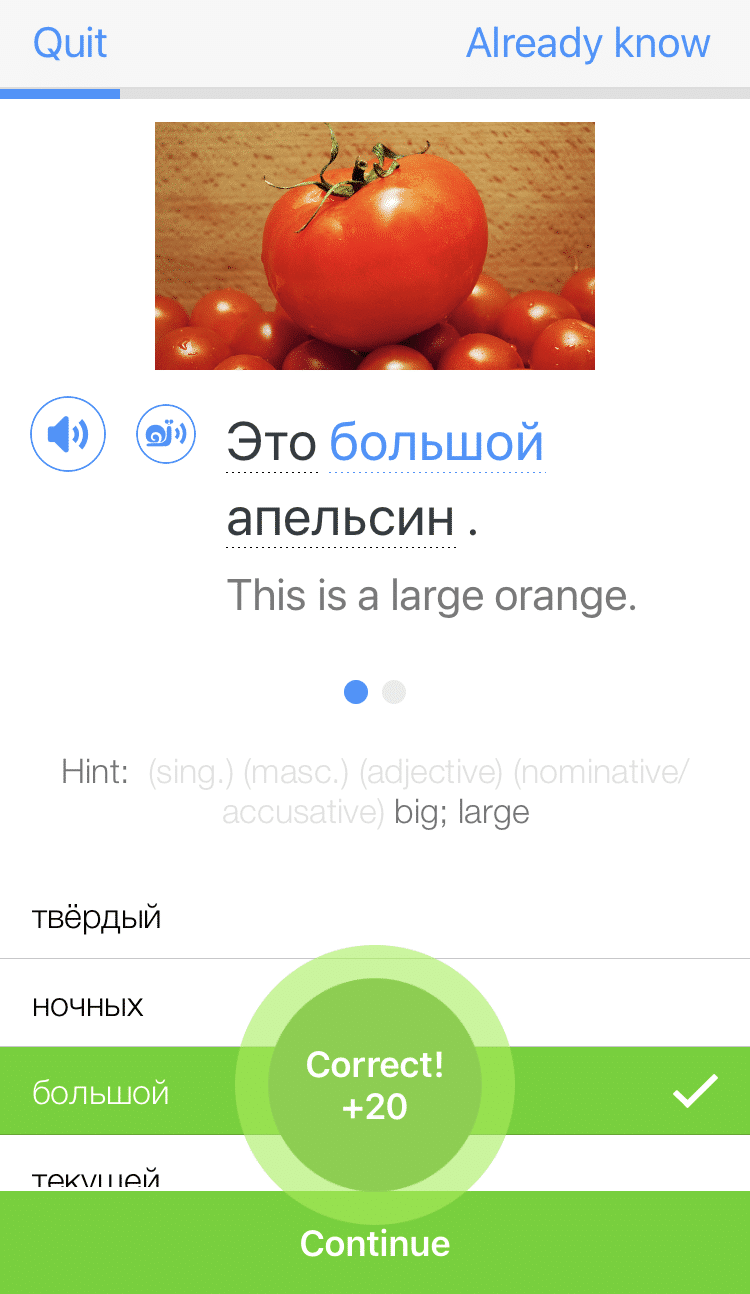
The Beginner’s Guide to Russian Adjectives
Russian adjectives are essential to sounding interesting when speaking Russian, but they play by their own rules!
In this post, you’ll master the art of using Russian adjectives correctly, as well as pick up new adjectives for your Russian repertoire.
You’ll also see some entertaining (yet effective) contextual examples to see the key adjective rules in practice.
Contents
- How Do Russian Adjectives Work?
- Short vs. Long Adjectives
- How to Form the Russian Comparative
- How to Form the Russian Superlative
- Resources for Learning to Love Russian Adjectives
- And One More Thing...
Download: This blog post is available as a convenient and portable PDF that you can take anywhere. Click here to get a copy. (Download)
How Do Russian Adjectives Work?
The differences between Russian and English adjectives can feel overwhelming, but they boil down to one principle: the word endings play the same role in Russian as sentence structure does in English.
Because Russian words change depending on the role they play in a sentence, that also means that the structures aren’t as rigid as they are in English. Keep this advantage in mind when dealing with some of the complications they add—you’ll find it all more tolerable.
Even so, it does give you a lot more to remember than in languages similar to English. While “beautiful” will always be “beautiful,” no matter what it’s describing or where it goes in a sentence, but красивый (beautiful) shape-shifts depending on the situation.
This isn’t as random as it sounds, though! Next, I’ll show you some rules that demonstrate the relatively predictable nature of Russian adjective endings, as well as some contextual examples.
If the stem ends in a hard consonant
Adjectives in Russian are typically listed in dictionaries by their masculine singular nominative forms.
“Hard stem” adjectives ending in -ый in that default dictionary form are the most common kind of Russian adjectives. The stem is the part of the word that you’re left with once you remove the ending (in this case, -ый).
For example, let’s look at the word первый (first). If you remove the -ый ending, you’re left with перв-, which is your stem ending in a hard consonant.
There are also some adjectives that fall into this group that end in -ой. These are known as stressed adjectives because the ending is stressed. An example is молодой (young). The stressed adjectives in this group take the same endings as adjectives that end in -ый, except for the nominative masculine singular and the nominative inanimate accusative (used when the noun is an inanimate object in the accusative).
| Case | Masc. | Fem. | Neut. | Plural |
| Nominative | -ый/-ой | -ая | -ое | -ые |
| Genitive | -ого | -ой | -ого | -ых |
| Accusative inan. | -ый/-ой | -ую | -ое | -ые |
| Accusative anim. | -ого | -ую | -ое | -ых |
| Dative | -ому | -ой | -ому | -ым |
| Instrumental | -ым | -ой (or -ою) | -ым | -ыми |
| Prepositional | -ом | -ой | -ом | -ых |
Did all those cases catch you off guard? That’s understandable. Since I won’t be getting into them in detail here, read this article for more information on what cases are and how to use them properly.
For now, let’s just look at a couple of examples of adjective use in the nominative case:
Первый день (the first day)
Молодой человек (the young man)
Here, both of these words are being used to modify masculine singular nouns in the nominative. So, each remains in its dictionary form and its ending matches the one in the top left box of our chart.
But what happens when that’s not the case, or rather, when that’s not the gender?
Let’s use the same adjectives, but with feminine singular nouns.
Первая неделя (the first week)
Молодая девушка (the young woman)
As you can see, the masculine singular endings have been removed from their stems and replaced with -ая, which is the ending for the feminine singular nominative (as you can see in the chart above).
Now, just for some real-world context and to explore the chart a little further, let’s take a look at a line from the Russian version of the trailer for the latest “Charlie’s Angels” remake:
Эй, ты чего застряла в первой гардеробной? (Hey, why are you stuck in Dressing Room 1?)
In this sentence, первый is present again, but it’s shifted from its default form for reasons beyond gender.
The noun гардеробной (dressing room), which is preceded by the preposition в (to, in, at), is in the prepositional case. It’s also a feminine noun and is singular. This means that первый, as the adjective modifying it, needs to inflect with the noun to become feminine, singular and prepositional. So the -ый ending has been removed and replaced with -ой.
By the way, if you checked the table above for that ending, you may have noticed the “or -ою” note for feminine/singular/prepositional. This is just an older ending for this particular declension that you might run across in written material.
If the adjective ends in -ний
“Soft stem” adjectives, or adjectives whose default forms end in -ний, take a different set of endings. There aren’t too many of these. Also, if you compare this chart to the one above, you’ll see that the pattern for declension is actually quite similar and mostly just differs by the first vowel in the ending.
| Case | Masc. | Fem. | Neut. | Plural |
| Nominative | -ий | -яя | -ее | -ие |
| Genitive | -его | -ей | -его | -их |
| Accusative inan. | -ий | -юю | -ее | -ие |
| Accusative anim. | -его | -юю | -ее | -их |
| Dative | -ему | -ей | -ему | -им |
| Instrumental | -им | -ей (or -ею) | -им | -ими |
| Prepositional | -ем | -ей | -ем | -их |
For an example of a soft stem adjective, let’s take the color синий (blue):
Синий стол (blue table)
Once again, синий is in the nominative here because it’s modifying a nominative noun, and that noun стол (table) is masculine and singular, so синий remains in its default dictionary state.
In the trailer for “Guardians of the Galaxy Vol. 2,” Rocket Raccoon asks if anyone has Scotch tape that he can use to wrap up an explosive device. When told that there isn’t any, he says (in the Russian version):
Ну, или синей изоленты хотя бы! (Well, or at least some blue electrical tape!)
Here, изоленты (electrical tape) is being used in the genitive, and it’s a feminine singular noun. So “blue” also needs to be feminine, singular and in the genitive.
If the stem ends in a guttural or sibilant
Okay, I know this is already a lot, but when adjective stems end in the letters г, к, х, ж, ч, ш or щ, things shake out a little differently.
Some Russian adjectives in their default masculine form end in -гий, -кий or -хий. These take the following endings:
| Case | Masc. | Fem. | Neut. | Plural |
| Nominative | -ий/-ой | -ая | -ое | -ие |
| Genitive | -ого | -ой | -ого | -их |
| Accusative inan. | -ий | -ую | -ое | -ие |
| Accusative anim. | -ого/-ой | -ую | -ое | -их |
| Dative | -ому | -ой | -ому | -им |
| Instrumental | -им | -ой (or -ою) | -им | -ими |
| Prepositional | -ом | -ой | -ом | -их |
Now, as you can probably already see here, you’ll also get some stressed adjectives in this group. Some adjectives end in г, к, х, ж, ч, ш or щ and are followed by -ой. Those use the same endings above except for in the nominative masculine singular and the accusative inanimate.
Other adjectives end in -жий, -чий, -ший or -щий. Here are the endings for those adjectives specifically:
| Case | Masc. | Fem. | Neut. | Plural |
| Nominative | -ий | -ая | -ее | -ие |
| Genitive | -его | -ей | -его | -их |
| Accusative inan. | -ий | -ую | -ее | -ие |
| Accusative anim. | -его | -ую | -ее | -их |
| Dative | -ему | -ей | -ему | -им |
| Instrumental | -им | -ей (or -ею) | -им | -ими |
| Prepositional | -ем | -ей | -ем | -их |
Let’s look at an example. A common Russian adjective is большой (big, large). Since the stem ends in ш and the default form ends in -ой, it falls into the first category above.
In this cute cartoon about a rabbit named Miffy, we learn where Miffy keeps her toys:
Миффи хранит свои игрушки в большой оранжевой корзине. (Miffy stores her toys in a large orange basket.)
The word for “basket” is feminine and is in the prepositional case here, along with the two adjectives that modify it, большой and оранжевой (orange).
Большой follows the rules laid out above. At first glance, it might look like nothing has changed about it at all, and technically, that’s true. But let’s look closer. The ending for feminine prepositional on the first chart above is -ой. So, we’re actually removing -ой and replacing it with another -ой, but you can see how we got there.
Now, let’s look at an adjective with an -ий ending:
Русский язык (Russian language)
Here, we’re looking at русский (Russian) in the nominative case along with язык, the masculine singular noun it’s modifying.
But let’s see how this adjective is used in a Russian cooking video on how to make borscht:
Украинский борщ является любимым блюдом многих русских людей… (Ukrainian borscht is the favorite dish of many Russian people…)
The form русских is modifying людей (people), which is a plural masculine noun being used in the genitive case, so it takes the ending for the plural genitive from the first table above. Hey, at least we don’t have to worry about genders in the plural!
If you’re really freaking out right now from all of the above, I would recommend watching this video on Russian adjectives from Antonia Romaker. It breaks things down in a very simple and gentle manner.
Remember, like so many other parts of learning Russian, the point here is not to remember all of this stuff right now. That would probably be impossible! But, if you can run with the general idea and stay calm, you’ll be able to get a lot more out of authentic Russian resources like books and movies.
And now, just a few more quick notes on adjectives. These could each take up a post in themselves, and we’ve already covered a lot, so we’ll just touch on these remaining concepts briefly.
Short vs. Long Adjectives
The short form is always in the nominative and used predicatively, meaning that rather than being placed right before a noun, it’s used in a sentence after where the word “is” or “are” would appear in English (in Russian, the verb for “to be” is almost always omitted in the present tense).
For example:
Это умная кошка. (This is a smart cat.)
Эта кошка умна. (This cat is smart.)
The short form of adjectives for masculine singular is the adjective stem (sometimes with an extra vowel inserted if the stem ends in a consonant cluster), with а or я added for the feminine version, о or е for neuter and ы or и for plural.
The default masculine form we’re working with here is умный (smart). Кошка is feminine (you can refer to a male cat as кот), so the default form needs to change to the feminine singular for the first sentence above.
In the second sentence, the short form is being used, with а being added to the stem to make it feminine.
Not all adjectives in Russian have a short form. Generally, the ones that do are qualitative adjectives that have to do with the measurable quality of a thing rather than its makeup or origin (for example, adjectives for nationality don’t have short forms).
It’s also worth noting that oftentimes, the stress placement changes when you use a short adjective form.
How to Form the Russian Comparative
In English, we compare qualities in people and things by using words like “more” or “less” and also by changing the form of adjectives. For example, we might say that one sandwich is “tastier” than another or that one room is “colder” than the one next to it.
Russian actually isn’t that different in this area. Here’s how to use adjectives comparatively in Russian.
By using add-ons
The Russian words for “more” and “less” are, respectively, более and менее. These words can simply go in front of an adjective to give the sense of “more” or “less.”
For example, высокий стол (the high table) can become более высокий стол (the higher table).
By changing adjectives for comparison
Another way to form the comparative is to drop off the adjective ending and add -ее:
Эта кошка умнее. (This cat is smarter.)
Some comparative adjectives are formed with -e and a shift in the letters that come before the ending.
For example, высокий (high) becomes выше (higher, like the Nyusha song).
As is the case in many languages, some Russian adjectives change completely when they switch to the comparative.
Notably, хороший (good) changes to лучше (better), and плохой (bad) switches to хуже (worse).
There are different ways to directly compare things or beings, but the simplest is by using чем (than):
Кошка умнее, чем собака. (The cat is smarter than the dog.)
How to Form the Russian Superlative
To form the superlative, you can put самый (the best) before a masculine adjective, самая before a feminine adjective and самое before a neuter adjective.
Она самая умная. (She is the smartest.)
Another easy way to express the same idea is with всех, which is the word for “all” in the genitive case:
Она умнее всех. (She is the smartest; literally, “She is smarter than all.”)
You can alternatively add -ейш to an adjective stem followed by -ий, -ая, -ое or -ие (for masculine, feminine, neuter or plural).
Она умнейшая. (She is the smartest.)
Stems that end in -к, -г, -х can be replaced with -ч, -ж and -ш followed by -айший (and changed in the same way above for other genders/numbers).
For example, высокий becomes высочайший (the highest).
Just like with the comparative, some superlative forms are irregular. For example, лучший (the best) and худший (the worst).
Resources for Learning to Love Russian Adjectives
The Cooljugator Russian Adjectives Declinator

This powerful little resource will give you declensions for over 21,000 Russian adjectives instantly.
The tool is simple and easy to use, providing clear examples in sentences and showing how adjectives change form in different contexts.
FluentU
With FluentU, you can see Russian adjectives used in context by watching short video clips from authentic Russian media—movies, TV shows, news segments and more.
Every video comes with a transcript and interactive subtitles that allow you to learn adjectives and other words while you watch. Then, you’ll take personalized quizzes and use the flashcard feature to review and memorize this new vocabulary.
100 Adjectives video from RussianPod101.com

This video will boost your vocabulary and set you up to start recognizing Russian adjectives in your writing and speech.
Just learning the default dictionary forms of adjectives will help you recognize them when you see and hear them, and you can get to know the subtleties of formation and usage over time.
Adjectives seem like they should be simple and harmless, but it turns out so many aspects of the language are woven into them in complex and subtle ways.
Still, the best way forward is to simply arm yourself with knowledge and charge ahead.
Download: This blog post is available as a convenient and portable PDF that you can take anywhere. Click here to get a copy. (Download)
If you love learning Russian and want to immerse yourself with authentic materials from Russia, then I should also tell you more about FluentU.
FluentU naturally and gradually eases you into learning the Russian language and culture. You'll learn real Russian as it's spoken by real Russian people!
FluentU has a very broad range of contemporary videos. Just a quick look will give you an idea of the variety of Russian-language content available on FluentU:
FluentU makes these native Russian videos approachable through interactive transcripts. Tap on any word to look it up instantly.
Access a complete interactive transcript of every video under the Dialogue tab. Easily review words and phrases with audio under Vocab.
All definitions have multiple examples, and they're written for Russian learners like you. Tap to add words you'd like to review to a vocab list.
And FluentU has a learn mode which turns every video into a language learning lesson. You can always swipe left or right to see more examples.
The best part? FluentU keeps track of your vocabulary, and gives you extra practice with difficult words. It'll even remind you when it’s time to review what you’ve learned. You'll have a 100% personalized experience.
Start using the FluentU website on your computer or tablet or, better yet, download the FluentU app from the iTunes or Google Play store. Click here to take advantage of our current sale! (Expires at the end of this month.)
And One More Thing...







